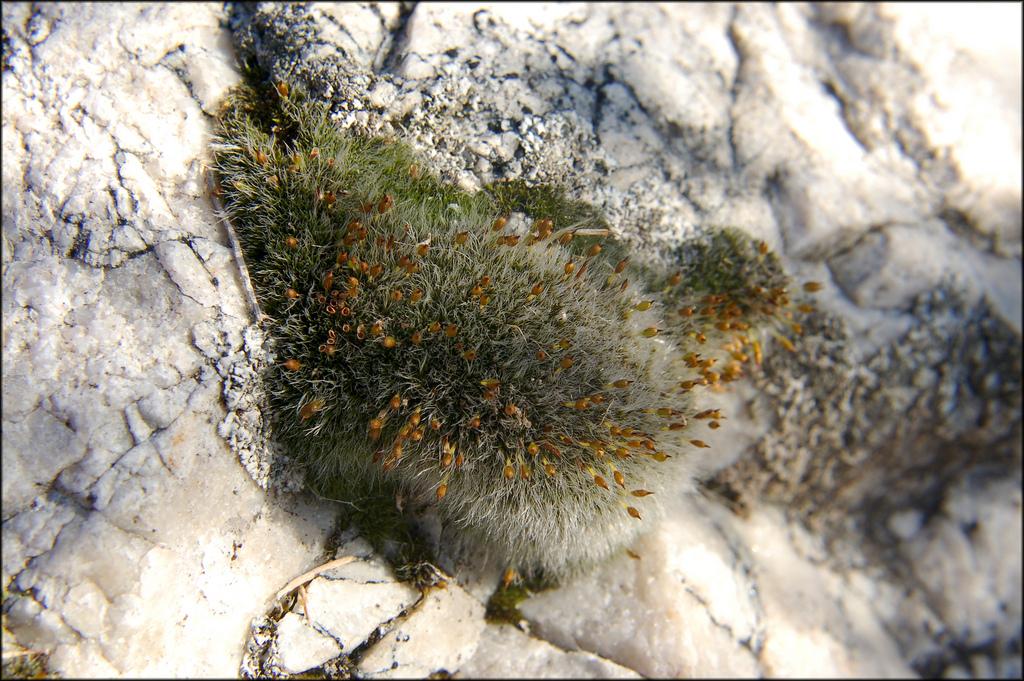
|
Family: Pottiaceae |
Plants bulbiform, gregarious or forming a thin turf, green distally, light brown proximally. Stems buried, usually short, 0.5-5 mm; hyalodermis absent, sclerodermis absent, central strand present, distinct; axillary hairs ca. 7 cells in length, all hyaline or proximal 1-2 cells brown. Cauline leaves appressed when dry, weakly spreading when moist; ovate to ligulate, adaxial surface broadly concave, 2-3.5 mm (inclusive of the 1.5-2 mm awn); base not differentiated in shape; distal margins weakly to broadly incurved to near apex, plane below, entire or denticulate above; apex obtuse to rounded, often weakly cucullate; costa long-excurrent as a smooth or denticulate, hyaline awn, occasionally absent in some leaves, adaxial outgrowths of (0-)3-4 lamellae longitudinally inserted on adaxial surface of costa, ca. 12 cells in height, occasionally lobed or branching, smooth or hollow-papillose, adaxial cells (differentiated as lamellae) in 4-6 rows; transverse section circular, adaxial epidermis apparently absent, adaxial stereid band absent, guide cells 2 in 1 layer, hydroid strand present, usually large, abaxial stereid band present, often weak and round to elliptic in section, abaxial epidermis present; proximal cells differentiated across leaf base, occasionally higher medially, rectangular, little wider than the distal cells or somewhat inflated, ca. 2-5:1, walls of basal cells thin; distal medial cells quadrate to shortly rectangular, often transversely elongated, 10-13(-20) µm wide, (2-)1:1(-2), 1-stratose; papillae absent or small, simple, solid or hollow and present abaxially and medially, 2-3 per lumen, cell walls thin to weakly thickened and weakly trigonous, flat or somewhat bulging on both sides or just abaxially. Specialized asexual reproduction absent. Sexual condition autoicous or paroicous. Perichaetia terminal, interior leaves not sheathing, elliptic, little differentiated, to 1.5 mm. Seta 0.4-3.5 mm. Capsule stegocarpous or rarely cleistocarpous, theca short-cylindric, often macrostomous, variously smooth, sulcate or ridged, 0.5-1.5 mm, annulus when present of ca. 3 rows somewhat vesiculose cells; operculum rostrate to conic-rostrate; peristome teeth absent or when present rudimentary, in a latticework borne on a membrane, weakly twisted, teeth to 300 µm. Calyptra cucullate or mitrate with 3-4 large lobes. Spores 25-38 µm. KOH distal laminal color reaction yellow, occasi Pterygoneurum is apparently most closely related to Crossidium, and, like that genus, has chlorophyllose filaments (occasionally) in addition to the adaxial costal lamellae, and the stem is densely clothed with pale, brown rhizoids. Pterygoneurum is common in arid regions of the West, forming a dense, low turf in exposed soil. The hyaline awns and short setae are distinctive in the field.
|
This project was made possible in part by the Institute of Museum and Library Services [MG-70-19-0057-19].
Powered by Symbiota



